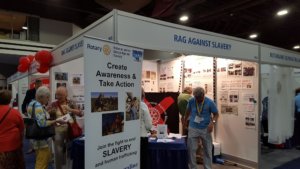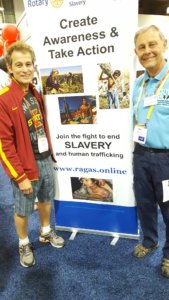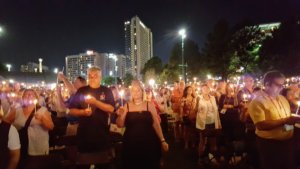Greetings to our Iowa Network Against Human Trafficking blog subscribers. I recently returned from the Rotary International Convention held in Atlanta, Georgia. There were 37,000 convention-goers from nearly 60 countries. This was my first Rotary International Convention. I was motivated to attend due to the rapidly growing interest by Rotarians worldwide in joining the fight to end the atrocious crime of human trafficking and modern day slavery.
I heard one Rotary leader say, “Slavery is a worldwide problem and Rotary has the potential to become the worldwide solution.” Rotary is the world’s largest service organization with 35,000 clubs in 90 countries, and 1.2 million members. If you are a member of Rotary, please consider proposing that your Club become educated on this growing crime and then partner with a local nonprofit and get your club to fund a local anti-trafficking project. If you are a local provider of prevention or survivor services, I encourage you to identify needs and apply for funding from your local Rotary Club.
The Rotary Club of Ames partnered with and funded YSS, the Network Against Human Trafficking, and several other local groups to undertake a major project entitled Human Trafficking in Central Iowa; How You can be Part of the Solution. I encourage you to partner with your local Rotary Club to carry out a similar project. Here is a link to a summary of the Ames Rotary project which you can access in order to generate ideas as to what you might want to consider. If I can be of any assistance, let me know.
The evening prior to the start of the convention I was invited to the Power of One Candlelight Vigil in support of trafficking survivors and held in Centennial Olympic Park in Atlanta. This vigil was organised by the Rotary Action Group Against Slavery, RAGAS, of which I am a member. RAGAS hoped for 500 marchers but over 2,000 showed up including John Germ, the Rotary International President. After we marched, I was able to sit with and meet President John Germ. RAGAS called the vigil The Power of One because each one of us has the power to make an impact to end slavery around the world, one life at a time. Below are two photos of the candlelight vigil.
 The next morning during the convention plenary session there were four human trafficking speakers including Iowa native Ashton Kutcher, U.S. Senator Bob Corker, and Gary Hagen, CEO, International Justice Mission. IJM is the world’s largest survivor service organization with locations in 17 countries. These three speakers were followed by a survivor from the state of Oregon named Rebecca Bender. Rebecca was rescued from forced prostitution at the age of 26, and has since healed her scars and set up her own anti-trafficking foundation. She had been arrested 7 times over the years for prostitution before law enforcement finally recognized that she was a trafficking and rape victim.
The next morning during the convention plenary session there were four human trafficking speakers including Iowa native Ashton Kutcher, U.S. Senator Bob Corker, and Gary Hagen, CEO, International Justice Mission. IJM is the world’s largest survivor service organization with locations in 17 countries. These three speakers were followed by a survivor from the state of Oregon named Rebecca Bender. Rebecca was rescued from forced prostitution at the age of 26, and has since healed her scars and set up her own anti-trafficking foundation. She had been arrested 7 times over the years for prostitution before law enforcement finally recognized that she was a trafficking and rape victim.
The speakers aimed to open the eyes of as many convention delegates as possible to this unseen world where millions languish in slavery because of poverty, because of corruption, and because of man’s greed for profit on the backs of vulnerable people.
 I volunteered to help to staff the RAGAS booth at the convention for the next 4 days. The trafficking speakers served as a springboard for interest and concern from delegates worldwide. The booth was always busy and the 2 trafficking convention workshops were oversubscribed with hundreds more in line waiting for an empty seat.
I volunteered to help to staff the RAGAS booth at the convention for the next 4 days. The trafficking speakers served as a springboard for interest and concern from delegates worldwide. The booth was always busy and the 2 trafficking convention workshops were oversubscribed with hundreds more in line waiting for an empty seat.
I met some remarkable people from around the world who have been fully engaged in the anti-trafficking fight for many years. The leadership of the Rotary Action Group Against Slavery were primarily from England and their hard work and courage is phenomenal. They formed RAGAS 8 years ago and it took four years for the board of Rotary International to approve the group as a fully-fledged RAG.
One of the first things I learned by interacting with anti-trafficking leaders from other nations is that they do not use the word trafficking but rather slavery. There were 17,000 delegates from nearly 60 other nations at the convention and most use the word slavery to define this growing worldwide crime. As a result, I was motivated to propose to the NAHT Board of Directors that we change our name to the Iowa Network Against Human Trafficking and Slavery. I learned that while the laws permitting slavery have been repealed everywhere, people around the world continue to be brutalized, broken, exploited and enslaved through violence or merely the threat of violence and in increasing numbers. Forty-six million is the latest estimate of the number of people held in slavery worldwide. Of this 46 million number, 21% are sex trafficked or as I heard over and over “rape for profit” and 79% are labor trafficked. There are more slaves in the world today than any other time in human history. This is the fastest-growing illicit trade in the world and currently stands as third largest.
I learned that while Rotarians have raised 1.5 million dollars to free children from the threat of polio, an increasing number of clubs are also working to free children from the bonds of slavery. They plan to achieve this by openly showing their support for the victims of exploitation, condemning known practices of slavery, and encouraging their fellow Rotarians and others to support the work of anti-slavery organizations
 The following are some words of wisdom from Mark Little, the founder and leader of RAGAS who is from England. Mark is shown with me on the right side of this photo. He has battled slavery all over the world.
The following are some words of wisdom from Mark Little, the founder and leader of RAGAS who is from England. Mark is shown with me on the right side of this photo. He has battled slavery all over the world.
The real impact of slavery
A few reflections by Mark Little
Definition of slavery….I am often asked for a definition of a slave. Quite simply, it is someone who is forced to work without pay, who is unable to leave and who is controlled by violence or the merely threat of violence. For these people their free will is taken away. Their labour, their lives and their minds are being consumed by someone else’s greed. But there is another dimension to slavery which is often forgotten.
It eliminates identity…..My visits to Child Slave Rehabilitation Centres in India, Nepal and Thailand these last 16 years have made me realise that one of the great crimes of slavery is that it goes beyond “servitude”. It goes to the point of eliminating the identity of the individual and the younger someone is taken into slavery the less likely they are able to repossess their own identity. In effect they become like zombies. Let me explain.,
Kesher Nankar was a slave who was born into bonded labour in India but he was eventually freed after 16 years of servitude. Some years after his release, whilst talking to the presenters of a documentary film on slavery, he expressed his feelings thus:
You people who are free, who were born free and who have always lived free, can never understand what it is like to be a slave. When I was a slave, I could never have dreamt that one day I would be standing here talking to you as a free man. My whole world was the farm where I was in bondage, and I simply could not have imagined anything else. Because someone, somewhere felt that I should not be a slave, and then did something about that, I am now a free man. But I could never have freed myself”. He went on to explain, “You must understand that when someone tells you, year after year that you have no rights to think, you stop thinking. If they say you must not cry, you stop crying.
That is what I mean when I say slavery eliminates the identity of the individual. This is the essential ingredient of modern day slavery, ie the total control of one person by another for the purpose of economic exploitation.
Liberation is not enough….For the countless numbers of children and adults who are rescued from their factory prisons, fields, homes, quarries, restaurants etc, liberation is not enough. In Europe or in the United States, a child kidnapped and held in captivity for a number of years would automatically be given counselling. It would be assumed that the child or adult would need help for years to come. The trauma of slavery is just as bad and the need for rehabilitation and reintegration back into the community, is just as important.
The need for rehabilitation ….Children (and the same applies for adults) when rescued are usually broken in body, mind and spirit and if taken directly back to their homes, would undoubtedly remain traumatised and withdrawn for the rest of their lives. They therefore need to go through a physical, mental and spiritual rehabilitation process. For the lucky few, this process is undertaken wherever there is a place available at a Safe House, Rehabilitation Centre or Trafficking Shelter. Sadly, there are not enough of these in the developing countries I have visited.
Rehabilitation is not an easy task….For the freed slave, freedom is not the end, only the beginning of the road back to normality. Rehabilitating traumatised minds is not an easy task. There is no body of knowledge and expertise built up by doctors and psychologists about how to help the freed slave. When slavery is the only life you have ever known or can ever remember, when your identity is wrapped up in your subjugation, finding a way through to a new life is very difficult, without the right kind of support
The Rehabilitation process… At some of the Rehabilitation Centres I have visited in India, the rescued children are re-educated a) to believe that they are worthwhile, not worthless, b) to learn to love themselves again and c) to play and mix with other children. Also because the majority of these children are from the lowest caste (the dalits) and are illiterate, they are taught to read and to write and to acquire trade skills such as welding, weaving, electronics, screen printing, tailoring, bicycle repairs, sewing etc. Acquiring these skills will enable them to more easily reintegrate back into their own villages..
How can YOU help…..Only a very small percentage of the number of people who are rescued from slavery are rehabilitated because of the paucity of Rehabilitation Centers. If freed slaves are given no support (both psychologically and financially) to rebuild their lives they will inevitably fall back into slavery. Some may even return to slavery by choice. So it is essential that the existing Rehabilitation Centers continue to receive support and that new ones are built to maximise the number of freed slaves who do receive the rehabilitation which they need to rebuild their lives. So if you want to help, volunteer or donate to support these vital centers.

